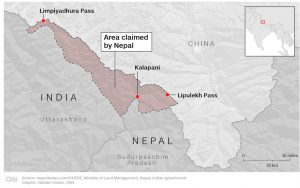India and Nepal Border disputes
Background
- India and Nepal share a 1,800km (1,118-mile) open border.
- Nepal has long claimed the areas of Limpiyadhura, Kalapani and Lipulekh under the 1816 Sugauli treaty with the British East India Company, although these areas have remained under the control of Indian troops since India fought a war with China in 1962.
- Under the Treaty of Sugauli, Kali river was agreed as the demarcation line for the boundary between India and Nepal.
- However, what is meant by “Kali River” in the upper reaches is unclear, which created the scope for different interpretations by the two neighbours.

- The latest border dispute between the countries began over India’s inauguration last month of a Himalayan link road cutting through the Lipulekh Himalayan pass, which will serve as the shortest route between capital New Delhi and Kailash-Mansarovar, a revered Hindu pilgrimage site in the Tibetan plateau.
Why in News?
- Nepal’s Parliament has cleared a Constitution Amendment Bill that endorses the country’s new map that includes the areas of as part of its territory.
- The formal inclusion of the map in the Constitution gives a rare kind of guarantee to the physical territory of the Nepalese state that makes future negotiations with India on the border issues difficult. However, Nepal has maintained that it remains open for dialogue.
- India, which controls the region has rejected the map, saying it is not based on historical facts or evidence.
Subscribe
Login
0 Comments
